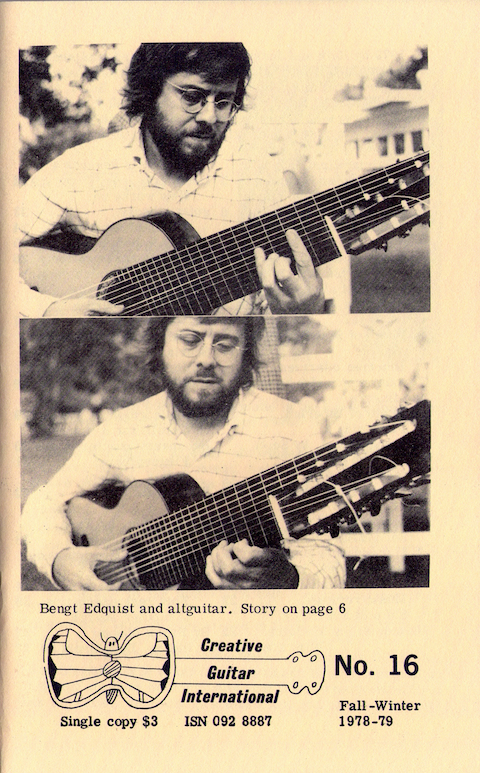
|
|
||
 |
||
Content highlights:
Interview with John Holmquist
Swedish 11 stringed altguitar
Interview with Gilbert Biberian
Christopher Parkening - Scott Bach
Guitar solo Recordações by Norberto Macedos
Music of Amerindia
Guitar - a poem by Graham Wade
|
|
|||||
|
© 1979 by Ruth and Jerry Mock, editors and publishers, Creative Guitar International is a classic guitar magazine published irregularly by Mockingbird Press, Box X, Alpine, TX 79830, USA. Subscription rates are $8.50 for three issues. Overseas subscriptions by surface mail. For overseas air mail subscription, add $2 an issue.
|
 |
||||
|
Musician first, says Toronto winner Holmquist 3
Swedish settings unique; a guitar tour of Sweden 6
Photo of Lundquist and
altguitar 7 Drawing of Swedish girl with lur by Melody Mock 8
Photos of altguitar, nyckelharpa, and salon at Satra Brunn 9
Photo of Skattungbyn
church 10 Biberian interview--
Toronto emphasis: hands and fingers 11 Photo of Biberian 12
Parkening a conservationist, by Scott Bach, with photo of Parkening and Bach 16
Letter from London: 'La Leone' by Colin Cooper 18
Second Barrios festival 19
Macedopiece published 19
Recordagoes, by Norberto Macedo (music) 20
Music reviews 22
Suite dedicated to Holmquist (by McGuire) 22
|
Bolcom's Seasons a
landmark 22
New works on
guitar theory 23
Music of Amerindia 24
18 Almeida pieces 25
|
||||
|
Rossimani in entirety 26
Baroque Spanish music; Brescianello Partita pleasant; Roncalli neglected composer 27
Behrend edits studies; Scarlatti balanced, playable; Children's songs of Bartok, Kodaly 28
Bach in D minor; Duo with accordion 29
Carulli for a change; Boccherini quintets move 30
Fingerpicking 31
Guitar, a poem By Graham Wade 32
How do little children learn music, by Fran Schick (with photo) 33
Improvisation: diagonal playing By Ron Manzanero 34
Foot rest alternative 36
Computer search By Frank Wagner 37
|
|||||
|
HOLMQUIST
|
|||||
|
The following interview was made in the London apartment of Gilbert Biberian in September 1978:
John Holmquist, 23-year-old winner of the 1978 Toronto Festival Guitar Solo Contest, said he did not attempt to figure out which pieces the judges would like.
Rather, he said he played music representative of his performances, which included three of five pieces from Suite No- 2 in the Popular Style by James McGuire, University of Minnesota guitar instructor (related story on p. 22).
Holmquist is the second Toronto Festival winner from Minnesota (Sharon Isbin, also from Minnesota, won the important Canadian competition in 1975).
Holmquist's selection of the McGuire work was in keeping with his philosophy toward the instrument. He said he made no attempt to show his virtuosity, but instead performed first as an artist, secondly as a musician, and only incidentally
3
|
|||||
|
Want ads, teacher listing, Dauphinais ad 38 |
|||||
|
|
|||||
|
|
|||
|
as a guitarist. He chose the guitar after playing several instruments including the piano, woodwinds, and the violin--simply because he enjoyed most playing the guitar.
Holmquist said in general Americans concentrate much on technique and put less emphasis on the music, in contrast with Europeans who concentrate on the music first. He feels technique and music should be developed side by side.
"You cannot have music without liberation from technique," Holmquist said. He added: "The best thing that could happen to the guitarist would be for him to lose his macho image."
Holmquist pointed out that the festival contestants included "many people with fantastique techniques."
"I do not have a standard right hand technique," the Toronto winner said. He pointed out that many of the well known performers today, such as Alirio Diaz and John Williams have different techniques.
Holmquist started on the piano at seven and turned to the guitar in a rock band playing bass. He played in this band two or three years, improvising and arranging. His father, an amateur jazz pianist, brought home classical pieces from the local guitar shop with the challenge "I bet you can't play these."
John said he was at a rebellious stage and accepted the challenges by his father. Holmquist's mother is an organist. He received encouragement in his music from both his father and his mother.
|
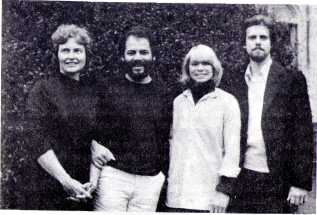 |
||
|
From left, Ruth Mock; Biberian and his American wife , Marianne; and Holmquist. Marianne, a social psychologist, teaches at the London School of Economics. She is from Philadelphia.
______________________________________________________ sounds (for example, sul tasto accompaniment in contrast to ponticello), and learning phrasing.
Holmquist gave as an ideal day of practice for him as four hours of work, including one-half to one and one-half hours on technique. However, he said before the Toronto festival he traveled three weeks and "if I got in 1 1/2 hours practice I was lucky." The week before the festival, he spent four days getting back into shape for his performance. He termed his Toronto performance as neither better nor worse than usual: "Representative of what I do."
What is next for Holmquist as the Toronto winner? He said before he sat down from his victory he was contacted by six or seven persons in regard to performances.
Holmquist's long range plans call for a London debut in Wigmore Hall Nov. 20. He also contemplates a New
|
|||
|
At the University of Minnesota Holmquist studied five years under Jeffery Van. He also participated in two workshops under Alirio Diaz.
Holmquist believes his two years performing in duo with Daniel Estrem helped his performance. He pointed out the need, as a duo performer, to coordinate such things as
|
|||
|
|
|||
|
4
|
5
|
||
|
|
|||
|
|
|||
|
York debut, but the cost of such a performance calls for caution--between $3,000 and $5,000, in contrast to the cost at Wigmore of 550 pounds (about $1,100).
Holmquist looks on the Toronto victory as a beginning, rather than an end achievement in his career. The need for a concert guitarist to win a prize in a major competition is
increasing, he noted.
Holmquist was living in a London flat, looking for new material. At the time he was working on a sonata by Biberian, and had done some work on Jeffery Van's Elegy. Holmquist also has done some duos with Sarah Martin, singer.
Holmquist was exuberant about the accomplishments of fellow Minnesotans, and said he and Sarah have worked some on Dominick Argento's Letters From Composers for high voice and guitar. He termed this 31-page group of pieces the "work of a genius," saying it would take at least a year's work "to get the minimum out of it." Argento's Letters are translations of letters from composers (Chopin, Mozart, Schubert, Bach, Debussy, Puccini and Schumann). The work was commissioned by Vern Sutton and Jeffery Van and the guitar part was edited by Van. The publisher is Boosey and Hawkes.
The guitar Holmquist used was made by Manouk Papazian of New York.
At the time, Holmquist was looking for a teaching position.
The Mock family's introduction to Sweden was in Västerås, the industrial city which has fought pollution with a central power producing boiler sending hot water through the pipes of the houses, and by sending merchandise underground in its central mall.
Our Swedish audiences seemed to appreciate both the quality and variety of the music which we performed on
|
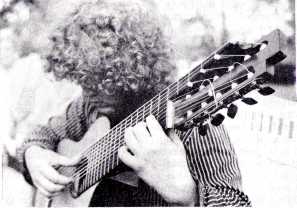 |
||
|
Bengt Lundquist performing on altguitar (altgitarren)
______________________________________________________ |
|||
|
guitars, at times with voices. The unique settings for our performances included the Västerås Art Museum, a modern church in Västerås, an 18th century church in Skattungbyn, with excellent acoustics and a view worthy of an Ingmar Bergman movie, which was filmed in part in this northern Dalarna Province village.
It was the picturesque setting of Satra Brunn, a 17th century farm village made into a summer spa, where we were introduced to the altguitar of Stockholm lutenist George Bolin. Ruth indicated to our Västerås friends that we wanted to meet guitarists and also were looking for the music of the country. We had just arrived in Satra Brunn when Bengt Edquist appeared and subsequently gave us two duo records he made with Borje Sandquist* which included the altguitar.
The altguitar has 11 strings and is tuned from the top (in a manner similar to the Baroque lute): g', d', a, f, c, F/G, E, D, C, B . The top six strings are tuned similar to a standard guitar at the third fret (except for the third
______________________________________________________ |
|||
|
*The records are Nos. 2379 070 Stereo (1974); and 2379 101 Stereo (1976); company address: Polydor AB, Box 3093, 171 03, Solna, Sweden. 7
|
|||
|
6
|
|||
|
|
|||
|
|
|||
|
string.) The bottom strings, of course, extend the range of the standard (prime) guitar downward a sixth, and also enhance the sound.
Bengt Lundquist, a guitarist who had studied four and one-half years, gave us a demonstration of the solo capabilities of the altguitar, performing several old pieces. The bass strings of the altguitar rang out in a deep and impressive contrast to the melody, adding nearly another dimension to the music. The thought came
to mind that some contemporary composer(s) should write for that instrument. Perhaps Michael Olsentie would. He attended two of our performances, and planned to study composition at Upsala University.
Lundquist said also Bolin makes a similar guitar to the altguitar, but with added bass range, called the contraguitar. The contraguitar is tuned (from the first string): e', b, g, d, A, E/D, C, B', A', G'and is being used in conjunction with a prime guitar, a tercerola and a requinto by a renown Stockholm guitar quartet.
Satra Brunn was an appropriate and interesting setting for the guitar performances. While motorcycle-like vehicles wheeled old ladies around the grounds of the spa for arthritis, Lundquist performed outside on the lawn where we ate pastries and drank milk and coffee. The summer spa grew up around a special well water containing iron and other minerals served to the sufferers. Music plays an important part of the life of Satra Brunn under Gunnar Julin, church organist and music director who arranged our program in their salon. Our program followed a church service during which Julin played the organ. He also played the long lur of birch bark, a trumpet-like instrument, while someone pulled down the Swedish flag. Julin's job at Satra Brunn is a
8
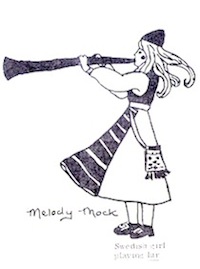 |
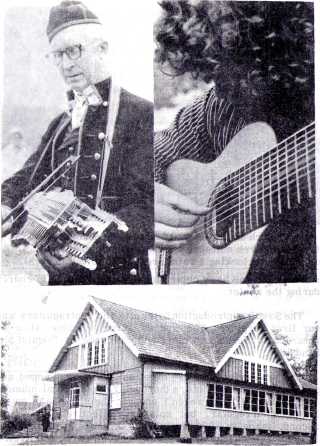 |
||
|
Right, closeup of Lundquist and altguitar; left, man with nyckelharpa during folk festival at Bingsjo, central Sweden. The instrument is bowed like a violin with keys (bottom) pushed down by fingers to obtain notes. It contains three layers of four strings and 12 tuning pegs. The instrument is 200 year old, but also is made today. Below is the salon at Satra Brunn. 9
|
|||
|
|
|||
|
|
|||
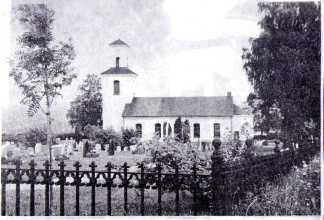 |
arranged (the music on both recordings was arranged by either Bengt or Borje), followed by a jazz improvisation of one of the pieces. "In the Dark" by Bix Beiderbecke, followed as did a version of a Scarlatti "Sonata. " Elsewhere on the record is another Scarlatti sonata, surprisingly, in a flamenco version. The record also contains vihuela pieces by Milano and Valderrabano which show the altguitar to advantage.
At the time Bengt and Borge were working on yet a third record. They are willing to be innovative and venturesome in their music, yet retain good taste. We hope they will be able to perform in the U.S. and carry their music and their altguitar here.
In Bingsjo, a village in northern Darlana, we were introduced to the growing pooularity of the Swedish folk music. In this village of about 300 one night 40,000 folk music enthusiasts gathered on a hillside to hear music from all over. We watched nearly 100 violinists perform together. The only guitars we saw were steel-strung. One unusual fretted instrument at the festival was the nickelharpa (the Swedish word) (see picture, page 9). The nickelharpa is bowed like a violin, with three layers of four strings and 12 tuning pegs. The performer pushes buttons to change pitch. The folk musicians played all night, and because of the traffic, we pitched our tent and went to sleep to the sound of the music on the hills of Bingsjo.
|
||
|
Church at Skattungbyn, where Bergman movie was filmed. Church entrance is through cemetery. Setting is on a hill overlooking a rain forest (note left of church).
_____________________________________________________ summer job and he is choir director in a Stockholm church during the winter.
The Swedish introduction to the alt- and contraguitars was our first surprise. The second surprise came when we returned to Texas and played the records by Edquist and Sandquist.
The two performers are excellent, get a good sound, and perform well in ensemble, a thoroughly professional musical combination. If that weren't enough, their choice of music is highly irregular, but splendidly effective. The first record, made in 1974, includes folk songs from Dalarna, Baroque French music, a Toccata by J. S. Bach, and Krell's "Mississippi Rag."
The second record, made in 1976, was recorded in London's Wigmore Hall, where the pair made an impressive appearance. The record begins with folk songs from Darlana in central Sweden, haunting and beautiful melodies well
10
|
|||
|
Toronto emphasis: hands and fingers
|
|||
|
The following interview about the 1978 Toronto Guitar Festival was made with Gilbert Biberian at his London apartment in September 1979. The conclusion will appear in CGI No. 17.
|
|||
|
Q. What did you do at Toronto and what was the response, and your impressions?
A. I felt that the emphasis was on hands and fingers and strings and frets, and on fingering: you do it this way you do it that way, but never on the reasons behind why you do such
|
|||
|
|
|||
|
11
|
|||
|
|
|||
|
|
||||
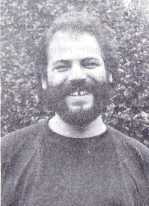 |
things, I went into some classes, but not all. The impression I got from the classes I eavesdropped on was that music did not constitute a very large part of the proceedings. This may very well have been justified in terms of the philosophy of the people giving the classes. They took it for granted that the musical understanding has been taken care, of; aesthetics have been taken care of, and now we deal with the mechanics of technique. But it soon dawned on me that wasn't the case (Yes, we can agree the student has been in structed in matters musical).
|
their shadings, their tempo, very clearly. This is not because I am particularly well trained as a musician but also because they gave me something to remember. And I wanted to retain in my memory that which they gave me. It very often happens as we go to a concert that we want to be amused, entertained, pandered to. It seldom occurs to us to be participants in this musical exchange. We go to a concert and play an extremely passive role. All this music slips off our minds and existence as if it is water off a duck's back. We have no retention of the event because: A. We don't know how to retain; we haven't got ears enough. B. Because the event is not memorable enough. There was one extremely memorable event in the 1975 Toronto Festival--the Leo Brouwer concert In addition one item in particular was memorable: the Bach Chaconne. There were two reasons for this being memorable: 1. The way he ornamented the Chaconne in the French Baroque tradition. To do that was daring enough. But, 2. He did it with such conviction that it was a real musical event. Whether you agree with it or not didn't matter in the least bit. But that it was a truly magical moment of music making was undeniable. Anyone with any musical sensitivity at all was all of a sudden aware of this and we got someting out of this that was truly memorable.
|
||
|
BIBERIAN
|
I did the very opposite. I did
|
|||
|
not deal with the guitar playing, I dealt with music playing and 1 dealt mainly with their ears. I wanted them not to be deaf (the motto for the festival was, "Don't Be Deaf). By this we meant you tried to remember everything possible of the previous day, so by the end of the week the participants could remember everything the performer did on the platform. |
||||
|
The other event which to me was memorable was the last night of the festival when we played my piece with guitars and percussion. It was so spontaneous and lovingly done it characterized the entire spirit of the festival which was pioneering, experimenting. It was not organized out of existence; it was very well run.
The 1978 festival was well run, and organized, but somehow it seems to me that in spite of the fact we had all these celebrated musicians, there was no sparkle.
Q. Did you feel there was nothing new you had heard before, or because it was the same people?
A. Not because it was the same people. It was a different time with different people with different minds. My expectations were not fulfilled. I did go with expectations because
13
|
||||
|
It appeared to me after the first day of proceedings that the people were not equipped to do this thing; that it never dawned on them that they should actually remember what happened. People will wax lyrical about a performer they heard 25 years ago and how he played this passage and how he played that passage on the G string. Memory of such a type comes about as a result of that musical experience having been extremely profound.
|
||||
|
Now it seems to me that events at the festival were not profound enough to cause such memories. This happens elsewhere. You go to a guitar concert and what do you remember about it? I remember very clearly a concert that Presti and Lagoya gave. I remember their phrasings,
12
|
||||
|
|
||||
|
|
|||
|
of the declaration that this was going to be a quest for new music. I expected the proportion of new music was going to be much higher than it was. There were two contemporary works per program in the evening concerts. By new, I mean written in the last five years. That is mediocre as far as I am concerned. To sit through performances of the 1st Lute Suite by Bach is interesting, but not what we were led to expect.
During the week I wanted to affect the ears of my students to such a degree that they would be unable to be deaf again; unable to go to a concert and not listen carefully and not participate properly. They've got to know a good deal about the music, beculturedpeople, have a lot of knowledge around the issue, so when they listen to a performer, they can say he is excellent because he has done such and such a way. By the same token they can listen to a performer who has not done his homework and say clearly: this man is a phoney, or not a good musician. The ability to say this is important for the audience, and should not be left up to the critic. In this way the monopoly of the critic can be broken. We have people who have incredible power over the destiny of musicians, sometimes justifiably, sometimes unjustifiably, and in one case in England, totally misguidedly, because the person I have in mind is not equipped to be a critic.
I think it is terribly wrong that the critic should have the ability to destroy a musician's career. It is also very wrong for young guitarists to think that by playing up to the critic they can safeguard their future. I think it is equally evil of the critic to encourage the impression that he is capable of destroying someone's career, with the consequence that young musicians come to him and cultivate him to safeguard their future. That is just as wrong as the critic who can in reality destroy a career.
Q. Is that why certain composer's pieces are performed?
A. It seems quite plausible as an explanation because there is no merit in the compositions. The compositions are terrible and will not stand up as real works, yet they are played, because it seems that there are ulterior motives. You play it once, give it an airing, show what the man has
|
done, and if it's a bad work, then you drop it. You don't go on glorifying mediocrity.
Q. Is this what you do when you ask composers to write
for you?
A. Yes, I think that's fair. You just don't know what kind of a work they are going to provide. We were stung in this way with one work that was ill-suited to us as a group. We gave it four performances and dropped it. We simply cannot go on playing apiece which is not as good as we want it to be and not suited to us.
Q. Does the composer know why you dropped it?
A. Yes.
Q. Is this embarrassing?
A. Of course, it's a delicate situation. If someone said to me "This piece of yours stinks," I would be upset for I would feel a sense of failure. But if I thought the work is good, it doesn't matter how many people came to me to say this work is terrible. It doesn't matter. It's your problem. I know this is a good work and you are not getting the point. But if I think it is a bad work, withdraw the work, but don't inflict it on people or performers simply because you are a critic and write articles (as I do now), and this position is equated to a position of power, where somebody could harm someone else simply because he can say Mr. so and so does not play my composition, he is a bad guitarist. This must be stopped.
Young performers must be instructed all over the world that they never have to do this. The more they are frightened of critics, the more they put critics in a position where they can harm them. I have met so many youngsters coming to England fearing critics, or "The Critic."
|
||
|
15
|
|||
|
|
|||
|
14
|
|||
|
|
|||
|
|
|||
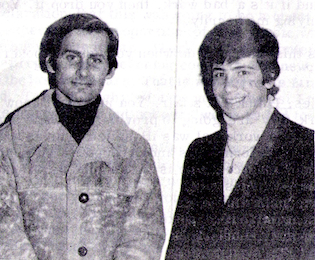 |
Parkening currently heads the guitar department at Montana State University, where he also taught a series of master classes during past summers.
Parkening also authored a series of volumes of Virtuoso Music for Guitar, the latest of which contains, in two volumes, the music from his latest album, Parkening and the Guitar. All are published by Sherry-Brener Ltd. of Chicago.
When he is on tour, Parkening's demanding schedule allows him virtually no time to practice except for the concerts themselves. When he is recording an album, however, that is a different story: He practices about five hours a day for at least two weeks before the recording session.
Parkening owns ten Ramirez guitars. He takes his "least" favorite (assuming one can distinguish his least favorite Ramirez, a major task in itself) guitar with him on tour, for fear of damage or theft. His guitars range in year from 1962 on. Which one does he record with? The one he bought in 1966.
Parkening first became interested in the guitar when he was 11, through the playing of his cousin, Jack Marshall (1921-1973). His cousin told him that after playing the classical style of guitar, he would be able to play any style with greater ease. After hearing his first Segovia album, Parkening decided to study the guitar.
One would wonder why Parkening, who was born and raised in California, would decide to make his home in Montana. Parkening attributes this to his father, who, he says, made sure that he grew up with an, appreciation of nature through many enjoyable days of fly-fishing together. Parkening loves the mountains, and the sub-zero temperatures in Montana during the winter do not interfere with his enjoyment of his beautiful environment.
I find it interesting to observe that Parkening is as concerned about nature, and wildlife as he is. Perhaps this
17
|
||
|
Scott Bach (right) with Christopher Parkening
|
|||
|
Scott Bach is one of the serious young guitarists who show considerable promise (as displayed in an impromptu concert he gave one Sunday evening in Chinatown.) The following interview Scott wrote (at 14) in the Spring of 1978:
By Scott Bach
|
|||
|
It was ten years ago that Christopher Parkening made his recording debut on Angel Records. The reclaimed guitarist, now 30, gave a recital recently at Rider College in Lawrenceville, New Jersey. He played a demanding program that consisted of works by Debussy, Satie, Handel, Albeniz and others. After the recital I was able to speak with him for a while and learn some interesting things about him.
|
|||
|
Parkening and his wife Barbara make their home in Montana. They live on their own ranch where they raise Andalusian and Arabian horses, and are both dedicated conservationists. So dedicated is he, in fact, that Parkening had with him a wildlife petition which he politely asked all his fans backstage to sign! His fans, of course, were more than happy to oblige. The petition urged protection of endangered species.
|
|||
|
|
|||
|
|
|||
|
quotation by him from his guitar method sums it up well: "It is the responsibility of each generation to preserve, in the highest quality, the beauty of music and the beauty of nature." I think that Parkening has fulfilled both of these in the noblest way possible. Not only does he impress one with his musicianship, but also with his humanity.
|
Paris winner from Sweden
|
||
|
Goran Sollscher of Sweden won the first prize as soloist in the 20th Concours International de Guitare held annually in Paris.
Other 1978 winners: Marie Smerdova of Czechoslovakia, Yoshinobu Iwanaga of Japan, and Karl Peterson of Denmark.
Theodore Antoniu of Greece won third prize in composition for his Stychomythia II and two honorable mention prizes were awarded, both to composers from Great Britain: Anthony Huggins for his The Waste Land--5 Improvisations, and to DavidNevens for his Soliloquim II. No first or second prizes were given.
Concours producer Robert Vidal wrote that the seventh annual summer guitar workshop will include master classes by John Williams and Antonio Lauro. For more information write Vidal at 116, Avenue du President-Kennedy. 75786 Paris, Cedex 16, France.
Second Barrios festival
The second Concurso y Festival de Guitarra in honor of the composer-guitarist Agustin Barrios (Mangoré) will be held in Mexico City in October, Barrios (1885-1944) was a Paraguayan guitarist. The Concurso (competition) will be heldOct. 15-19, and the festival Oct. 11-26. For information write Sociedad Mangoré, A. C. , Apartado Postal 1414, Mexico 1, D. F. » Mexico.
|
|||
|
Letter from London 'La Leone'
|
|||
|
By Colin Cooper
|
|||
|
The controversy still rages. José Romanillos states that the famous "La Leone" Torres owned by Alice Artzt is not genuine, though undeniably it makes a very pretty sound. Miss Artzt, having asked the opinion of Mr. Romanillos, is naturally upset that he has failed to confirm her opinion of the instrument's authenticity.
Most of us would be overjoyed to possess any guitar capable of emitting the beautiful sounds that Miss Artzt extracts from hers. Does the label really matter? Only when it carries a high price tag, maybe. And therein lies the root of the argument. A guitar with so much invested in it by way of personal commitment, publicity and possibly even money, just has to be genuine.
An English magazine bored its readers to the point of witlessness with protracted correspondence about this 'issue.' CGI, with no correspondence column, has a distinct advantage.
THE EYES HAVE IT
|
|||
|
|
|||
|
"You have to play this like a beautiful woman's eyes"--reported advice from Segovia to a male student.
What advice would he give to a female student?
________________________________________________ WHILE THEY LAST, back issues of Creative Guitar International available at $3 each. Write for free tables of contents for past issues, Vols. 1-3, Nos. 1-3; and Nos. 10-15. Box X, Alpine, TX 79830, USA 18
|
On pages 20-21 is Recordacoes, choro, by Norberto Macedo. In playing this music it is important to leave the fingers down, especially in the figure in measure four, which is repeated in the third score. "Recordacoes" is an easy version of a longer piece and shows how Macedo is able to simplify, yet keep the basic melody and chord structure. For story on Brazillian Macedo, who composes and performs his compositions on radio and records, see CGI No. 15, pp. 32-33. Recordacoes means remembrances. 19
|
||
|
|
|||
|
|
||
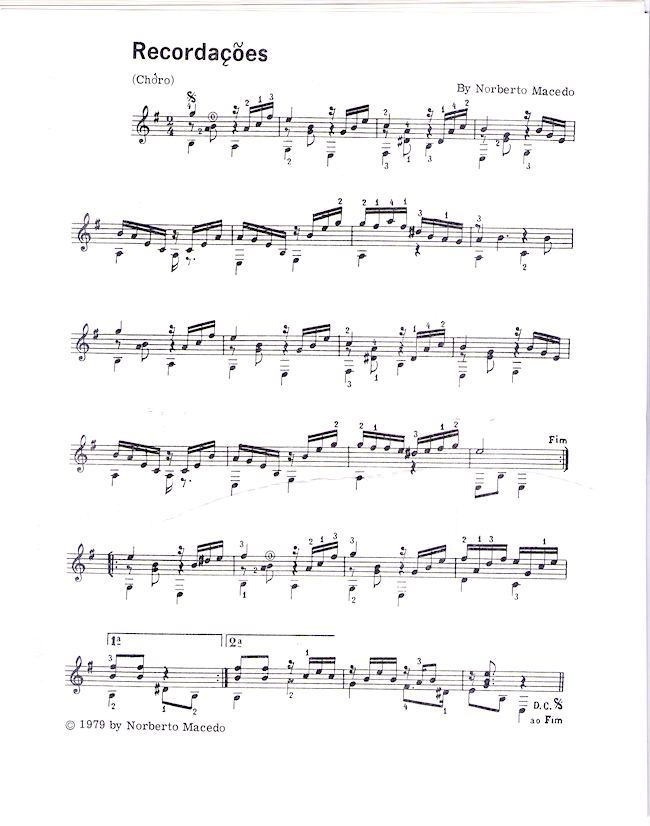 |
||
|
|
||
|
|
|||
|
Music reviews
|
minutes.
It seems like only months ago the complaint regarding guitar music was that there were no major works available. It is now nearing the time when one has a great selection of contemporary music from which to choose for major guitar works.
A landmark in American guitar music is Bolcom's Seasons, written by a pianist composer, for and performed by Michael Lorimer. And the work was commissioned by the Michigan Council for the Arts, rare for a guitar work.
American composers have been too reluctant to write for the guitar; therefore it is a tribute to Bolcom to tackle the project, and a tribute to Bolcom's ingenuity as a composer, that his work won plaudits from New York Times critic Raymond Ericson for "a new work that must be counted among the more original to be heard in a long time.. .his entertaining and ingenious score proved delightful."
Bolcom uses countless devices for the music, including the opening where the guitarist makes vocal sounds, and including the strictly tonal fifth movement, "Harvest Time andWinter'sOnset." The fifth movement, in4/4 time, and the third movement, in 3/4 time, are the only movements with definite time signatures.
Bolcom's Seasons is a concert grade piece, edited and fingered by Lorimer.
|
||
|
Due to the number of inquiries we have had and the interest in new music, CGI is expanding it's music review section.
|
|||
|
Suite dedicated to Holmquist
|
|||
|
James McGuire, Suite No. 2 in Popular Style, Cavata Music Publishers, 941 Deleware Ave, , Mendota Heights, MN 55118, 11 pp. , five movements.
|
|||
|
This suite is dedicated to John Holmquist, who performed three movements of it in winning the 1978 Toronto Guitar Festival solo competition.* It underscores a new trend in the world of solo concert guitar, acceptance of 20th century music. Holmquist pointed out the music is jazz-based, for McGuire is a jazz guitarist, in addition to his duties as guitar instructor at the University of Minnesota, Mankato State University andGustavusAdolphus College in St. Peter, MN, south of Minneapolis. Inaddition the music is guitar istic, with well-placed arpeggios, as well as interesting harmony. With the exception of the page-long "Intermezzo" which is of intermediate difficulty, the pieces are for the advanced guitarist, but obviously worth the effort and a welcome expansion of the standard repertoire.
McGuire is one of the growing group of guitar education specialists--the first applied music degree holder from Mankato State University, Mankato, MN. He also has written and performed Romantic Fantasy for Guitar and String Orchestra with the Mankato State University Orchestra.
|
|||
|
New works on guitar theory
|
|||
|
Fred Harz, Harmonielehre fur gitarre, 181 pp. , and Guitar Jazz Harmony. 197 pp., Musikverlage Hans Gerig, Drususgasse 7-11, 5000 Koln 1, West Germany.
Anyone who has tried to play guitar music on the piano understands there are some incompatible features of the two. Therefore, it is frustrating to try to apply piano theory to the guitar, even though the piano is a good instrument for theory. But good voice leading and avoiding some parallel
23
|
|||
|
Also due to be published are McGuire's Suite No. 1 in Popular Style, and Ten Etudes.
|
|||
|
Bolcom's Seasons a landmark
|
|||
|
William Bolcom, Seasons for solo guitar. Edward B. Marks
Music Corp. Five movements; music: 17 pp.; duration: 15
______________________________________________ * For interview with Holmquist, see pp. 3-6 22
|
|||
|
|
|||
|
|
|||
|
intervals is just as valid on the guitar as the piano, and also much more helpful to learn on the guitar, if that is your instrument. In fact, it is one of the problems of the conservatory for the guitarist that he is forced to spread himself very thin to learn things he should be learning on the guitar.
These books by Fred Harz, therefore, are a significant addition to guitar pedagogy. What a welcome change to have harmonic examples from Villa-Lobos, Sor, Aguado, for the guitar; to show a guitar version of Bach's Prelude (originally in C minor). Harz has correctly placed emphasis on harmonizing phrases for the guitar.
In contrast, Harz has placed emphasis on chords in his Guitar Jazz Harmony. After a brief mention of pentatonic scales and some blue note references, he goes into chord formations. Although he emphasizes chord charts, he lays the foundation with standard notation, which he also uses liberally to help the student visualize the functions of tablature. The Jazz Harmony text also contains examples from important jazz writers and performers, in standard notation (i.e., "The Fox" by Laurindo Almeida, "Garota de Ipanema" by Jobim and Moraes, and examples of the guitar styles of Joe Pass and Barney Kessel.
What a pity these books are only in German. But the musical examples need no translation and solutions to the problems are available in separate volumes. How appropriate it would be if arrangements could be made for translation and distribution of these two volumes in the U. S. Both books would be excellent texts for guitar theory courses.
|
Americans almost unexplored musical heritage. It is a credit to Benites that he has brough tus this music, and to the Japanese that they have published it. The music is, as Benites says, interesting and unusual rhythmically and melodically. It is progressive, beginning with simple pieces he has collected south of the border, rarely seen or heard in the U. S. (perhaps the best known is the beautiful Oaxacan dance, "Zandunga"), and thoroughly fingered, especially for the left hand.
Benites suggests his Indian work (intersperced with his own compositions) be used for teaching along with the two volumes of his Mangoré collection, which offer a good sampling of the Paraguayan composer's works. The first volume includes Mangoré's "El Sueno de la Muneca"; "Danza Paraguaya"; "Choro da Saudade"; and"La Catedral." The second volume includes "Danza Guarani"; an attractive "Villancico de Navidad"; a work for two guitars, "Estudio en Si Menor"; and several pages of tremolo studies.
The Barrios works play well on the guitar, but are not easy, about on a level with the sixth book of Sagreras or above grade VI on the British grading system. Benites wrote "Only men of mediocre ability will live slaving under a traumatizing, frustrating and disconcerting methodology. Methods are stultifying products of an age in which there was no right to freedom. A method can be progressive today, and become decadent tomorrow. " He is correct in suggesting that the Barrios works would be appropriate for use in teaching. They fill in a gap between the classics of Sor and present day music, offering a rare collection of music of Latin America, from an era nearly forgotten. Playing this music, it is understandable why such a figure as John Williams would perform the works of Mangorg on an album (CBS 76662).
|
||
|
|
|||
|
Jesds Benites (editor), A. Barrios Mangoré, No. 1, 63 pp., 23 pieces; A. Barrios Mangoré No. 2, 85 pp., 25 pieces; Classic Music of Amerindia, 55 pp., 26 pieces, Zen-On Music Company, 25 Higashi Gokencho, Shinjuku-ku, Tokyo, Japan.
Amerindia refers to American Indian (by which he refers to Indian music of Mexico and south) with its rich, and by
24
|
18 Almeida pieces
|
||
|
Laurindo Almeida, Guitariana, 39 pp., 18 solos; and The Music of Isaac Albeniz, 34 pp. , seven pieces, Brazil-liance Music Publishing, 4104 Witzel Drive, Sherman Oaks, CA 91432.
25
|
|||
|
|
|||
|
|
|||
|
Almeida is one of the most versatile of the guitarists in the U. S. He became well-known as a jazz player and for his introduction of Bossa Nova, then performed on art music records, especially the music of Brazil.
The compositions in Guitariana are either his own or his arrangements and include "Amazonia", "Mystified" and "Brazilliance." The music is mostly for the advanced student with easier pieces being "Pavana for Pancho", "Choro Para Olga" and "English Air." A simplified version of some of pieces in this album would perhaps also be welcome.
The Albeniz album includes such familiar pieces as "Leyenda" and "Tango." With each piece is a careful explanation of how to play difficult passages, sometimes with practice suggestions. The pieces are difficult and should be attempted by the advanced student, although some guitarists learn the mechanics of some of the pieces to the exclusion of other music. The pieces are well fingered for the left hand, and of course the Albeniz music is suited to the guitar.
|
Baroque Spanish music
|
||
|
Bruno Tonazzi (ed.), Antologia di Chitarristi del Barocco Spagnolo, Edizioni Suvini Zerboni (Boosey & Hawkes, distributor), 16 pp., 11 pieces.
Much of the charm of this music is due to the slurs, trills and vibrato. Tne music of Gaspar Sanz, Francisco Guereau, and Santiago de Murcia is especially suitable for performance on guitar because of its ornaments. Tonazzi indicates where he has deviated from the original text in his transcriptions and shows the original (in standard notation) as footnotes. The works are designed to be performed on the Baroque or classic guitar.
Tne music is in the intermediate range, the main problems being the ornamentation.
|
|||
|
Brescianello Partita pleasant
|
|||
|
|
|||
|
Rossiniani in entirety
|
Guiseppe Antonio Brescianello, Partita XVI for guitar, from the 18th Partita for colascione (ed. Ruggero Chiesa),
Brescianello was a contemporary of Bach (ca. 1690-1757), The colascione was an instrument like the guitar, with six courses. The Partita is very pleasant music to the ear, not difficult (intermediate), rich with embelishments, well edited and fingered.
|
||
|
Mauro Giuliani, Rossiniana, No. 2, Op. 120 for guitar, and No, 3, Op. 121, for guitar, edited and fingeredby Ruggero Chiesa, Edizioni Suvini Zerboni, Milano (Boosey & Hawkes, distributor); No. 2, 24 pp., 8 movements, and No. 3, 25 pp. , 10 movements.
Julian Bream edited Rossiniani No. 3, then recorded it on RCA Red Seal ARL 1-0711 in 1974. This music is a collection of operatic potpourris, brought back to life by Bream, who showed what can be done with the classics. Our legacy of early classic guitar composers is limited, and Bream has shown the way to revival of these works. Likely this kind of thing will be done many times by those who will really study this music to discover its style and content. It is well fingered by Chiesa and playable for an upper intermediate to advanced student.
|
|||
|
Roncalli neglected composer
|
|||
|
Ludovico Roncalli, Suite No. 4 in D-Dur, and No.3 in H-Moll, fingered and edited by Jurgen Libbert. Edition Preissler, Munich 1, 11 movements (JP70201).
Ludovico Roncalli, Suite in Re Minore, fingered and edited by Paolo Paolini, Ricordi, 7 pp., 6 movements.
Roncalli certainly has been neglected when you consider
|
|||
|
26
|
|||
|
|
|||
|
27
|
|||
|
|
|||
|
|
||||
|
the dearth of Baroque guitar composers. These, therefore, are overdue editions. Apparently little is known of Roncalli, but he appears to have been a 17th century count. In keeping with some of the present day practices, Libert has indicated his changes from the original script, and also has added the sixth string sparingly, in small type. Although both versions are suitable for an early intermediate student and give a definite Baroque flavor, Libbert's choice of works in two sharps is somewhat easier for the guitarist than Paolini's suite in one flat.
|
guitars, Boosey & Hawkes, 26 pp.. 14 pieces for one guitar, seven pieces for two guitars.
In arranging these children's songs, collected and edited by Bartók and Kodaly, for the guitar, Sugar has performed much the same service as did Halsey Stevens for cello, with his work of the same name (Hungarian Children's Songs). Sugar's work though, should not be confused with music for performance by children. The songs range from intermediate grade to advanced in difficulty. The duets are easier than the solos. The pieces are, on the whole, well done, with interesting harmonies. For the melodies Sugar used Bartók and Kodaly's Collection of Hungarian Folk Music, and gives reference numbers for each piece.
|
|||
|
Behrend edits studies
|
||||
|
|
||||
|
Siegfried Behrend, Elementar Etuden for guitar, book three (JP7030/III), Edition Preissler, Munich.
This book is the third volume in a series of four which also follows Preliminary Studies for Guitar (JP7041), Medieval Dances (jPTOPTTlmd the three-volume Guitar Music for Beginners (JP7023/I, II, III.)
Elementar Etuden contains a grouping of studies by Sor. Carulli, Giuliani and Aguado, roughly of equal difficulty for about the third or fourth year of study. They contain helpful metronome markings and left hand fingering.
Scarlatti balanced, playable
Domenico Scarlatti, Studio-Reihe Gitarre (Guitar Studio Series), Jurgen Libbert, editor. Edition Preissler, 8 Munich 1. 9 pp., two sonatas, E major (K20); and A minor (K54).
Scarlatti tends to ring true on the guitar and these duos are no exception. Well edited and fingered by Libbert, they are guitaristic, balanced as to parts, and a delight to play and hear.
|
Bach in D minor
|
|||
|
John Sebastian Bach, Suite BWV 998, edited and fingered by Alvaro Company, Edizioni Suvini Zerboni, distributed by Boosey and Hawkes; music 22 pages, five movements.
This Bach lute suite originally was in C minor. Company wrote that although A minor would have been an easier key, he used the key of D minor to get the added range in the bass. (John Williams' version of the suite is in A minor). Company has reconstructed the suite from two German manuscripts — one for harpsichord in standard notation, the other in Baroque lute tablature. Both works are reproduced along with the present version. Company also has given double staffs to indicate where he has made changes from his sources.
In his "Preface," Company presents logically why he thinks the Suite was written for the lute (the original manuscript has not been found).
BWV 998 is one of Bach's most difficult works, Company wrote, noting thatlutenists of the time excluded the "Fugue" and "Double."
|
||||
|
|
||||
|
Children's songs of Bartók, Kodaly
|
Duo with accordion
|
|||
|
|
||||
|
Rezso Sugar, Hungarian Children's Songs for one and two
|
Hans M. A. Hauswirth, Sonatine II, for guitar and
|
|||
|
|
||||
|
28
|
29
|
|||
|
|
||||
|
|
|||
|
accordion or piano, Musikverlag Josef Presssler, Munich, 8 pp.. 3 movements, score and guitar part.
This work is written in the classic style and serves to augment the dearth of literature in the field. It is appropriate student recital material and of intermediate difficulty.
|
Another Galilei
|
||
|
Michelangelo Galilei, II Primo Libro D'Intavolatura di Liu to (edited and fingered by Ruggero Chiesa), Edizioni Suvini Zerboni, Milano, (Boosey & Hawkes, distributor), 76 pp. of music, 52 pieces.
Michelangelo Galilei's more famous brother was an astronomer. Their father was a renowned musician of the Renaissance. Michelangelo apparently studied lute under his father, and in face of a declining interest in the instrument in Italy, spent most of his life in Poland and Bavaria, where interest in the instrument continued. This work contains most of his compositions, examples of early Baroque music. Some of these pieces can be played on a guitar with F# tuning, but without effect of the lower bass notes of the 10-string lute which Galilei used, tuned, below the bottom E- D, C (or C#),BandA.
This music should be accessible to a guitar, and it is--at least to the contraguitar built by George Bolin of Sweden.
|
|||
|
Carulli for a change
|
|||
|
Fernando Sor, Seconda Grande Sonata (Op. 25), revised and fingered by Ruggero Chiesa, 28 pp. , four movements; and Ferdinando Carulli. Solo for guitar, Op. 76, No. 2, edited by Alvaro Company fingered by Company and Stefano Michelucci, 10 pp. , two movements, Suvini Zerboni (Boosey & Hawkes, distributor).
Having been deluged with music from the pen of Giuliani, perhaps it is appropriate that we hear from his contemporary, Carulli. Carulli's music, as well as that of some of his contemporaries, appears in poorly edited, poorly selected anthologies for beginners, and results in some prejudice against him. This well edited romantic piece is welcome.
Chiesa pointed out that many guitarists are unfamiliar with this music "which demands a brilliant technique too often superior to their ability." Perhaps it is with some irony that the Sor piece begins in three flats, a key usually avoided by guitarists. Parts of the work will be familiar to many, though, especially the fourth movement.
|
|||
|
Fingerpicking
|
|||
|
Ken Perlman, Fingerpicking Fiddle Tunes (traditional dance music arranged for finger style guitar), Chappel & Co., Inc. (distributed by Theodore Presser Co., Elkan Vogel, Inc.), 72pp., 31 pieces.
Perlman developed these pieces from versions of fiddle tunes "as played by old-timey or Irish musicians of the American Northeast, and are almost always in the key that the fiddler would play them." The keys are mostly D, G, C or their relative minors. It is largely two-part music, each in tablature and standard notation. Included are a few well known ditties ("Arkansas Traveler," "Old Joe Clarke,") and many lesser known ones. They have a special charm and come off well on the guitar as arranged, and recorded on an accompanying record. Perlman said he used a small steel-string guitar, but they are playable on the classic guitar.
|
|||
|
Boccherini quintets move
|
|||
|
Luigi Boccherini, Quintetto VI in Sol Maggiore (G, 450), for violin 1, violin 2, viola, cello and guitar, edited by Ruggero Chiesa, Edizioni Suvini Zerboni (Boosey & Hawkes, distributor), 38 pp., three movements.
This is the sixth in a series of Boccherini's quintets with guitar (Chiesa wrote there are eight in all). Typical of Boccherini's music, it is fast-moving, lively as well as interesting. The guitar part is interesting but not overly demanding. In contrast to some of the quintets, the cello part is modest and also not particularly demanding. 30
|
|||
|
31
|
|||
|
|
|||
|
|
||||
|
How do little children learn
music ?
|
 |
|||
|
sing
with your Arabic mouth
your long dubious history
sing
of half-remembered things
sing
of when you were young
of scented forests in your sun-coloured song
sing
of nights hidden
of dead lovers
of secrets on balconies
sing
with restraint
or sobbing like a sick child
|
||||
|
FRAN SCHICK
|
||||
|
Children under seven are capable of learning far more than we usually entrust to them. Although a child might learn to play music at a faster pace if he were older, the question a parent must ask is, does he want to make music? If he indicates that he does, I feel he should be given a chance.
Because pre-schoolers have little experience in reading, they will learn by doing. Just as they learn their mother -tongue by listening and speaking before reading and writing, so they must first hear music at home, especially singing with their parents. For at least two months young children should have class instruction in music. Besides the many concepts they gain from the varied activities, pre-schoolers are better motivated and more relaxed in a small group. Furthermore, your pre-schooler needs you there - -especially as a memory bank. You will be his practice coach, giving help mostly as he asks for it. Parents are requested to stay in the background during the lesson, as the child cannot learn from two teachers at the same time. Although you need not sit poker-faced for the duration, do not make remarks related to his performance or discuss his affairs with other parents. Also, please refrain from correcting your child's behavior during the lesson. As the mother of an active three-year-old, I can tolerate a lot of pre-school
|
||||
|
sing
trembling your voice at the edge of the sea murmur river-like or humming like a hive
sing
to memory
draw from dry souls
some desire
till we become
what we truly are
sing
of some city
tell exiles of home
of that which we would be
and would become
|
||||
|
|
||||
|
Wade, an English guitarist and poet, wrote Guitar for Creative Guitar International. 32
|
33
|
|||
|
|
||||
|
|
||||
|
antics. In rare cases when a child is disruptive, I may take him aside for a talk or, as a last resort, send him to his parent. If your child is sent to sit with you, behave matter-of-factly; do not lecture him. Keep him seated, but allow him to observe the class.
When helping him at home, it is vital that you give positive support—not false praise, but emphasis on work done well. For instance if your daughter uses incorrect fingering, do not stop her playing and say, "No! Mrs. Schick says you have to do it this way." Rather, let her finish,then say, "Now, see if you can do this. " You may have noticed that children love to repeat a new skill endlessly. They will do the same with music unless we adults call it "practice" and imply that it is boring.
At first, your child may see little use for regular practice. Scheduling is an issue I leave up to the individual parent, because personally, I would be inclined to sit with the child five minutes now and then, striving for every day.
These classes are solely for the enjoyment of the child. It is my belief that children who are competent at performing some pet skill, whether playing piano or counting the warts on bullfrogs, are happier children.
|
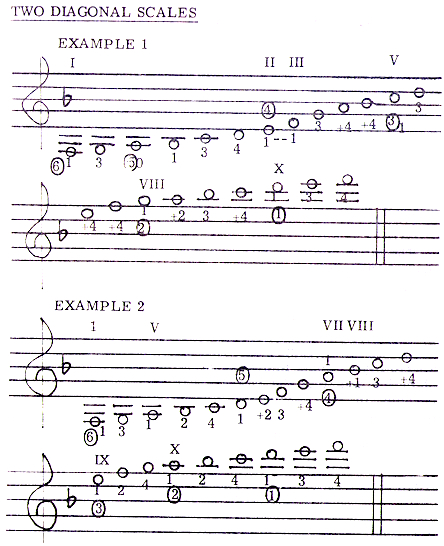 |
|||
|
Improvisation: diagonal playing
|
||||
|
By Ron Manzanero
|
3rd of a series
|
|||
|
In diagonal playing we will span the fretboard. We will be using a combination of position playing and linear single string playing. In this manner, one will be able to start from the lowest possible note of a key to the highest. Those who practice the Segovia scales will be familiar with this aspect of scale playing.
In order to accomplish this technique, one will have to use a combination of position shifting, left hand stretching, and sliding on half steps. For this example, I will once again be using the key of Fmajor like the first article. Also in the example, note where the slides and stretches are used. The + indicates a fret is skipped.
|
||||
|
_________________________________________________
The Mock family has been invited to perform in Europe again during the summer of 1979, which will make their third European ensemble performance tour in the past four years. It will be the fifth summer of performance touring for the Mocks, who played in Mexico and Colorado ia 1975- in the eastern U.S., England, Germany and Spain in 1976; in the eastern US. and Quebec in 1977; and in Sweden, Germany and Spain in 1978. |
||||
|
|
||||
|
34
|
||||
|
|
||||
|
|
||||
|
Foot rest alternative
|
intermission (inadvertantly), he returned to the stage to perform, to have the audience wait while he recovered his cushion.
The Mock family was unable to find a suitable music stand until the problem was resolved by George Dauphinais (see ad, P. 38) who offers a one-piece, substantial music stand ideal for guitarists, adjustable to about 17" from the floor to the bottom of the music. For those who prefer the foot rest, Dauphinais offers a substantial wooden rest, with an angle which seems to alleviate the stress problem.
|
|||
|
AlanProctor of Guitar Works has developed a fascinating alternative to the foot rest—a cushion which rests on the thigh under the guitar (see ad, p. 38).
Perhaps the most important feature of the cushion was singled out by Gilbert Biberian. Proctor quoted a letter from Biberian saying he uses the cushion and ". . .all tension is removed from the legs, hip and back."
It is this tension which shows up so often in foot rests, although there is considerable difference in design of various foot rests.
The Mock family took along cushions on their summer tour of 1978. Julian, eight, could not always reach the floor sitting down, so did not use one. The girls, Melody and her mother Ruth, wore formal dresses, so were unable to use the strap attached to the cushion. Jerry used it throughout the tour and has continued to use it since. The family gave more than 50 concerts under various circumstances, so are able to report some impressions of the cushion. Ruth's main objection was that the cushion was not practical for her because of the varying heights of chairs furnished for performances. She reported the cushion does relieve the tension, but in chairs slightly high, as is often the case, the cushion did not lift her guitar sufficiently for performance. In reply, Proctor furnished an extra large cushion which is designed to overcome the height difficulty. Jerry used the cushion whenever he practiced or performed (and still does). He does not use the strap, however. At first he had trouble adjusting the cushion to stay out of the way when playing in high positions, but slowly resolved this problem. He is now completely satisfied. In addition to alleviating some stress, the cushion is better for singing (for Frederic Chrislip's description of finding a suitable singing position, see CGI, No. 13, pp. 32-33.) Proctor wrote that Chrislip now uses the cushion.
One unexpected problem Jerry found with the cushion: on two occasions, after taking the cushion off the stage during
36
|
||||
|
Computer search
|
||||
|
By Frank Wagner
|
A continuing series
|
|||
|
Intensity of Guitar Playing as a Function of Auditory -Feedback, Journal of the Acoustical Society of America, v63, n6, pl930-2932.
Nontraditional Guitar Techniques for Educable and Trainable Mentally-Retarded Residents in Music Therapy Activities, Journal of Music Therapy, vl4, nl, p39-42,
1977.
Rate-Contingent Guitar Rental to Decelerate Stereotyped Head-Face-Touching of an Adult Male Psychiatric-Patient, Behavior Therapy, v7. nl, pl04-109, 1976.
Train Whistle Guitar. Black Scholar, v7, nl, p51-52, 1975 (book review).
Electric Rock—Rock Musicians Guide to Electric Guitar and Amplifiers, Journal of Leisure Research. v5. n2. p90-90. 1973.
Effect of Musical Accompaniment on Attitude—Guitar as a Prop for Persuasion, Journal of Applied Social Psychology, v2. n4, p350-359. 1972":
Method for Adjusting the Pitch of Top and Back Plates of the Cello, Acoustica v36, n4, Dec. 1976, p307-312.
37
|
||||
|
|
||||
|
|
||||
|
Teacher directory
|
Want ads
|
|||
|
|
||||
|
Memo
|
||||
|
|
||||
|
JOSEPH GALLUCCI 165 Augusta St. Irvington, NJ 07111
|
TILLMAN HOWARD SCHAFER 45 Elm St. Bedford. MA 01730
|
TO: Librarian
SUBJECT: Guitarists
Are you furnishing your guitarist patrons with the information they need about the classic guitar ? Why not subscribe to Creative Guitar International ?
|
||
|
RUTH MOCK, Alpine Regional Guitar Choir, Box X, Alpine. TX 79830 BIG NEW CATALOG OF MUSIC BY MAIL. 108 pages, $1. Jim Forest Guitar Studios, 6538 Reef ton, Cypress, CA90630.
THE PATENTED GUITAR CUSHION: First sensible alternative to the foot stool. Endorsed by Michael Lorimer, Liona Boyd and David Perry. Also—the GUITARIST'S KIT: An all suede leather kit with nail accesories and tuning fork. Write for brochure to: GUITAR WORKS (CGI), P.O. Box 65, Mt. Rainier, MD 20822.
|
||||
|
TO: Guitar teacher
SUBJECT: Your students
Are you helping your students keep up to date on what is new in classic guitar ? Why not show this issue to the person in charge of subscriptions at your school library and ask him to subscribe to Creative Guitar International
|
||||
 |
||||
|
TO: Head of Music Department SUBJECT: Your guitar department
Is your library furnishing your guitar department with the latest, most authoritative information on the classic guitar ? Why not show this issue to the person in charge of subscriptions at your school library and ask him to subscribe to Creative Guitar International
|
||||
|
Creative Guitar International is $8. 50for 3 issues. Box X, Alpine, TX 79830
|
||||
|
|
||||